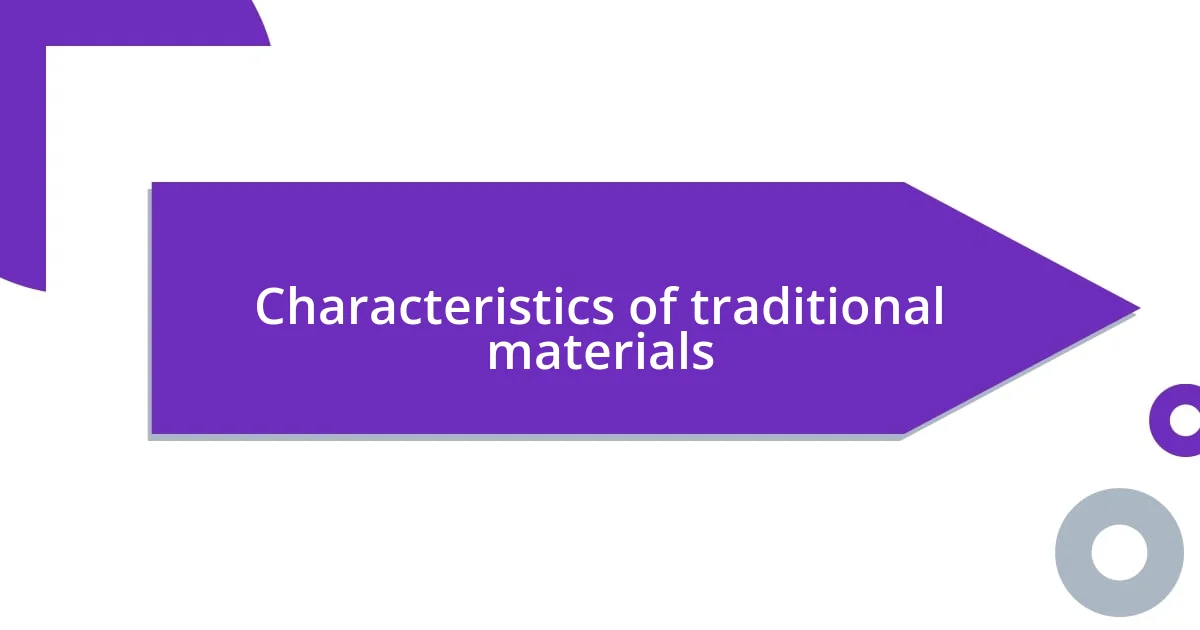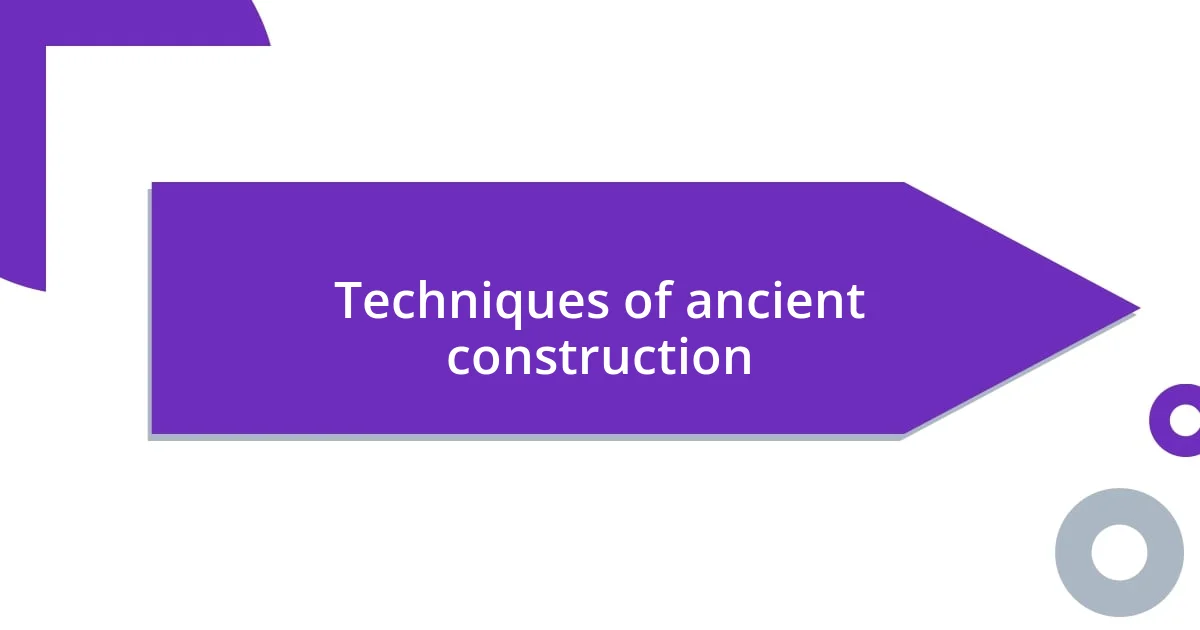Key takeaways:
- Historical building materials reflect cultural values, techniques, and human creativity, serving as a connection between the past and present.
- Material selection impacts a building’s longevity, functionality, and environmental footprint, with sustainable choices promoting energy efficiency.
- Preserving architectural heritage involves traditional craftsmanship, modern technology integration, and community engagement to honor past stories while adapting to contemporary needs.

Understanding historical building materials
Historical building materials tell a fascinating story about the cultures that created them. I vividly remember visiting an ancient Roman site, where the robust use of concrete amazed me, especially considering it’s been a trusted building material for centuries. Have you ever thought about how the choices in materials reflected the values and technology of the time?
As I wandered through the remnants of medieval castles, I felt the weight of the stone walls. Those stones weren’t just functional; they were emblematic of strength and permanence. When I touched the weathered surface, I couldn’t help but wonder how many generations had walked those same paths and what their lives were like. It’s incredible to think how these materials serve as a connection between past and present.
In researching wooden structures, I learned about timber framing techniques used by early settlers and how they adapted to their environments. I find it inspiring to see how ingenuity shaped the experience of living in harmony with nature. Doesn’t it make you appreciate the beauty in simplicity and resourcefulness of past architects? It’s a testament to how historical building materials were more than just functional; they were expressions of human experience and creativity.

Importance of material selection
Material selection is crucial in architectural design as it plays a significant role in a building’s longevity and functionality. When I worked on a restoration project, I realized how important it was to match the original materials not just for aesthetic reasons but to maintain structural integrity. Each material tells a part of the building’s story, and using a different one could alter its character entirely.
I remember visiting a local library where the warm embrace of wood contrasted beautifully with the coldness of steel in its modern extension. It struck me how the choice of materials could evoke emotions—wood felt inviting, while steel conveyed strength. It made me reflect on how the right materials can create an atmosphere that welcomes or even inspires people who occupy the space.
The environmental impact of material choice can’t be overlooked. For instance, while researching sustainable options, I learned that certain materials reduce carbon footprints and promote energy efficiency, which is becoming ever more important today. When walking through a green building crafted from reclaimed wood and sustainable concrete, I felt reassured. It was a compelling reminder that our choices can positively influence the environment.
| Material Type | Impact on Development |
|---|---|
| Wood | Creates warmth and comfort, showcasing natural beauty. |
| Stone | Portrays durability and historical significance. |
| Concrete | Offers strength and versatility, suitable for various structures. |
| Steel | Provides modern appeal and foundational strength in contemporary designs. |
| Sustainable Materials | Enhances environmental responsibility and reduces carbon footprints. |

Characteristics of traditional materials
Traditional building materials exhibit unique characteristics that reflect both the natural environment and the cultural context from which they originate. I’ve noticed how brick, with its earthy tones, has an unparalleled sense of warmth. It reminds me of a quaint cottage I once stumbled upon in a small village; those red bricks felt like they were holding the whispers of countless stories. It’s fascinating how these materials not only serve functional purposes but create a sense of place that resonates with nostalgia.
Here are some key characteristics of traditional materials:
- Natural Aesthetics: Emphasizes the beauty of raw materials, like timber or stone, showcasing craftsmanship.
- Durability: Many traditional materials, such as granite or slate, stand the test of time, symbolizing resilience and stability.
- Adaptability: Materials like straw bales, traditionally used in certain regions, demonstrate how local resources can be effectively utilized in construction.
- Thermal Properties: Materials such as adobe possess excellent insulation qualities, keeping interiors comfortable through varying weather conditions.
- Cultural Significance: Each material often carries cultural narratives and practices, linking communities to their history and identity.
In my travels, I’ve often found myself captivated by the intricate details in plasterwork of historical buildings. The craftsmanship tells a story of artistry and labor, where you can almost feel the artisans’ pride radiating through the walls. I vividly remember standing in front of an exquisite old church, mesmerized by the ornate decorations that seemed to come alive in the sunlight. Each flaw in the material added character, inviting me to appreciate the dedication behind its creation. It’s these subtle nuances that elevate traditional materials from mere resources to embodiments of human expression and cultural identity.

Techniques of ancient construction
Ancient construction techniques varied widely yet remarkably showcased human ingenuity. For instance, many civilizations utilized the corbel arch, a striking technique where stones were stacked so that each layer protruded slightly beyond the one below, creating a dramatic effect. I remember feeling a sense of awe when I first walked through a corbelled tunnel in an ancient site—it felt like stepping back in time, surrounded by sheer determination and resourcefulness.
The use of local materials was also a hallmark of ancient builders, allowing structures to blend seamlessly with their environments. While exploring a forgotten ruin nestled in the mountains, I observed how the stones mirrored the landscape, as if the building itself had grown from the earth. This struck me deeply; it made me realize that architecture isn’t just about aesthetics but about honoring and integrating with the natural world.
Finally, techniques like rammed earth construction captured my attention due to their sustainability. This method involves compacting soil into formwork to create long-lasting walls, making efficient use of abundant resources. I felt a sense of connection when standing beside a modern adaptation of this age-old technique, which echoed the past while still addressing contemporary environmental concerns. It raised a question for me: What can we learn from these ancient methods to create a sustainable future? In my experience, looking back at our architectural history often sheds light on practical solutions for today’s challenges.

Sustainability lessons from the past
Reflecting on historical building materials, one powerful lesson about sustainability stands out: the importance of resourcefulness. I once visited a century-old home in a rural area and learned that its walls were built using locally sourced clay and straw. This not only minimized transportation emissions but also exemplified an efficient use of regional resources. It struck me then, how often we overlook the materials right in our backyards. Could we be more in tune with sourcing sustainable materials that require less energy to produce?
Moreover, the practice of reusing materials, a common theme in historical architecture, is something we can’t ignore. I fondly remember touring an ancient marketplace that had beautifully repurposed stone columns from an older structure. The seamless blending of history and practicality reminded me that sustainability isn’t just a trend; it’s a timeless practice. It got me thinking: why do we shy away from salvaging resources when past generations embraced it as a norm?
Finally, the mastery of natural insulation methods employed by our ancestors offers a compelling framework for green building today. I recall my first experience in a traditional earth-sheltered home; the cool interior air was a stark contrast to the summer heat outside. Such constructions reduce energy needs significantly, encouraging us to consider how past wisdom can inform our future designs. It leads me to ponder—how can we integrate these age-old techniques into modern architecture to cultivate a more sustainable approach?

Modern applications of historical materials
When looking at modern applications of historical materials, one can’t help but appreciate the revival of techniques like adobe construction. I recently visited a community center built using this method, and standing in that space, I felt the warmth of the earth beneath my feet. The thick walls not only kept the interior cool but also resonated with a sense of tradition. It made me wonder: how many contemporary buildings can pass the test of time the way adobe structures often do?
Another exciting aspect is the reintroduction of materials like timber, specifically in the form of cross-laminated timber (CLT), which pays homage to ancient timber framing but in a modern context. I remember watching a project unfold where layers of timber were bonded together to form strong yet lightweight panels. The beauty of it lies not just in its efficiency but in the warmth it brings; that’s something I genuinely feel is missing in too many steel and glass structures today. This approach raises an important question for us: can we find a balance between modern aesthetics and the warmth of historical materials?
Lastly, the use of reclaimed brick in contemporary architecture is a perfect example of merging old with new. During a recent renovation project, I was thrilled to see how these aged bricks brought a unique character to an otherwise new building. Each brick tells a story, contributing to a rich tapestry of history. It struck me then that reusing such materials isn’t only environmentally friendly; it’s a way of honoring craftsmanship from the past. It makes me curious about how we can further embrace historical materials to create not just buildings, but spaces that tell stories.

Preserving architectural heritage today
Preserving architectural heritage today requires a collective effort to maintain traditional techniques and aesthetics while adapting to modern needs. I remember visiting a historic preservation workshop where artisans painstakingly restored intricate masonry work. As I watched them lovingly mimic centuries-old techniques, I realized that these skills are just as essential today as they ever were. Isn’t it fascinating how hands-on craftsmanship can bridge the gap between the past and present?
Another important aspect of preservation is the integration of modern technologies that complement traditional structures. I’ve seen firsthand how energy-efficient retrofitting can breathe new life into older buildings without compromising their integrity. When I toured a recently renovated historic site, it was incredible to see solar panels discreetly nestled on the roof without overshadowing its charm. It made me think: how can we innovate while honoring the rich storytelling woven into these walls?
Ultimately, fostering a sense of community around historic preservation is vital for its success. I remember attending a local meeting where residents passionately shared their ties to the historic buildings in our town. It was clear that these structures embody not just our architectural heritage but also our collective identity. How can we inspire future generations to appreciate and protect these treasures? By fostering discussions on significance, we can create a culture of stewardship that ensures these architectural stories continue to resonate for years to come.












